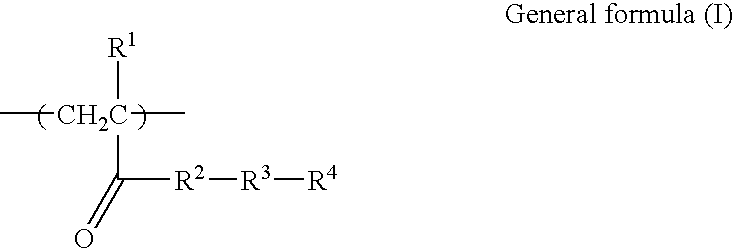Dye-containing curable composition, color filter, and producing process thereof
a curable composition and dye technology, applied in the direction of photosensitive materials, instruments, photomechanical equipment, etc., can solve the problems of limited organic pigment primary particle size, unsuitable pigment dispersion type, and inability to meet the requirements of application, etc., to achieve high sensitivity, high resolving power, and high production efficiency
- Summary
- Abstract
- Description
- Claims
- Application Information
AI Technical Summary
Benefits of technology
Problems solved by technology
Method used
Image
Examples
examples
[0239]The present invention will be explained specifically by the following examples which are not intended as a limitation thereof as far as they are within the scope of the invention. The term “part” means part by mass unless indicated otherwise.
example a1
(1) Preparation of a Dye-containing Curable Composition (Dye-containing Resist Solution)
[0240]
Ethyl lactate70.27partsCompound of Specific Example I-14.77parts(Binder of the 1st embodiment)Dipentaerythritol hexaacrylate7.16partsPolymerization inhibitor0.0036part(p-Methoxyphenol)Fluorine surfactant ethyl lactate solution4.17partsPhoto-polymerization initiator2.06partsTAZ-107 (Midori Kagaku)Acid yellow 42 bis(ditolylguanidine)salt6.00parts
[0241]The above components were mixed and dissolved to give a dye-containing curable composition (dye-containing resist solution).
(2) Preparation of an Under-coating Glass Substrate
[0242]A glass substrate (Corning 1737) was ultra-sonicated with 1% NaOH-water, then washed with water and baked for drying (200° C. / 30 min).
[0243]A solution of CT-2000L (Fuji Film Arch) was then applied on the washed glass substrate by a spin coater so that the film thickness was 2 μm, and dried under heating at 220° C. for 1 hour to give an under-coating glass substrate.
(3...
examples a2
to A7
[0252]In preparing the dye-containing curable composition (dye-containing resist solution) of Example A1 (1), a variety of binders as shown in Table 1 were employed in place of the binder of the compound (I-1) (the binder of the invention). Otherwise, the preparation of the composition was carried out in the same manner as in Example A1. The pattern image was again formed and evaluated in the same manner.
PUM
| Property | Measurement | Unit |
|---|---|---|
| glass transition temperature | aaaaa | aaaaa |
| thickness | aaaaa | aaaaa |
| Tg | aaaaa | aaaaa |
Abstract
Description
Claims
Application Information
 Login to View More
Login to View More - R&D
- Intellectual Property
- Life Sciences
- Materials
- Tech Scout
- Unparalleled Data Quality
- Higher Quality Content
- 60% Fewer Hallucinations
Browse by: Latest US Patents, China's latest patents, Technical Efficacy Thesaurus, Application Domain, Technology Topic, Popular Technical Reports.
© 2025 PatSnap. All rights reserved.Legal|Privacy policy|Modern Slavery Act Transparency Statement|Sitemap|About US| Contact US: help@patsnap.com



